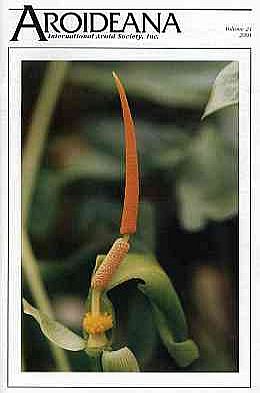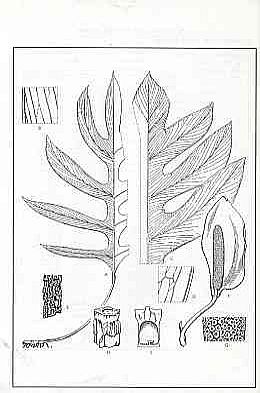|
|



Your search for articles published in volume 24 has found 14 articles.

| 
|
Articles of 3 pages or less are available for free to IAS members for download, and longer articles for $5. Articles from issues in 2016 and beyond are only available electronically, and are free to current members when they are logged in.
Please remember that all Aroideana articles are protected by copyright, and you may NOT distribute even electronic copies without permission from the authors or editor.
(Issue) |
||||
| Peter C. Boyce | Editorial
This article available FREE to IAS Members with a PERSONAL login. LOGIN, REGISTER or JOIN | |||
| Josef Bogner, J. D. Bastmeijer | In Memoriam--H. C .D. de Wit (1909-1999)
This article available FREE to IAS Members with a PERSONAL login. LOGIN, REGISTER or JOIN | |||
| ABSTRACT: On 16 March 1999 Professor Dr. Hendrik Cornelius Dirk de Wit died at the age of 89 years. For people interested in aroids he is well known for his revisions of the genera Lagel1Ctnclra and Cryptocoryne. | ||||
| Eduardo G. Gonçalves | A new Anthurium (Araceae) from Serra do Cipó (Buy) | |||
| ABSTRACT: A new species of Anthurium (A. megapetiolatum E.G.Gonc.) from Serra do Cipo, Minas Gerais state, Southeastern Brazil is described and illustrated. It belongs to the section Urospadix Engl. and is tentatively included in the subsection 1nsculptinervia Eng!. because of its adaxially sunken primary lateral veins. Anthurium megapetiolatum is compared to other species in the subsection 1nsculptinervia. | ||||
| Eduardo G. Gonçalves, E. R. Salviani | Anthurium xanthophylloides G. M. Barroso (Araceae) Refound in EspÃrito Santo State (Buy) | |||
| ABSTRACT: Anthurium xanthophylloides G. M. Barroso has been re-found in the wild for the first time since the type collection, in two different localities. An expanded description is presented, together with a detailed illustration. The species was initially considered as pertaining to section Cardiolonchium Schott, but it is now included in section Pachyneurium Schott here because of the involute ptyxis. Ecological and conservation remarks are provided. | ||||
| Eduardo G. Gonçalves, E. R. Salviani | Notes on a wild population of Philodendron spiritus-sancti G. G. Bunting (Philodendron 'Santa Leopoldina') (Buy) | |||
| ABSTRACT: One of the most aesthetically desirable species in the genus Philodendron (P. spiritus-sancti G. S. Bunting), commonly known as Philodendron 'Santa Leopoldina' has been rediscovered in the wild in the forests of southeastern Espfrito Santo state, close to the town of Domingo Martins. The species is illustrated and a new description is furnished. Information on its ecology, as well as the conservation status of the species is presented. Philodendron spiritus-sancti is considered in serious danger of extinction because of its restricted range and limited regeneration in the wild. | ||||
| Wilbert L. A. Hetterscheid, Van Du Nguyen | Three new species of Typhonium (Araceae) from Vietnam (Buy) | |||
| ABSTRACT: Three new species of Typhonium (T. bachmaense, T. lineare and T. penicillatum) are described from Vietnam. | ||||
| Wilbert L. A. Hetterscheid, D. Sookchaloem, Jin Murata | Typhonium (Araceae) of Thailand: New species and a revised key (Buy) | |||
| ABSTRACT: Seventeen new species of Typhonium (T. adnatum, T. digitatum, T. echinulatum, T. gallowayi, T. gagnepainii, T. glaucum, T. griseum, T. medusae, T. orb! folium, T. pedunculatum, T. pusillum, T. reflexum, T. saraburiensis, T. subglobosum, T. tentaculatum, T. varians and T. bognerianum) are described from Thailand. A key to all Thai Typhonium is presented. Province coding follows the flora of Thailand format. | ||||
| Dorothy E. Shaw | Fertile florets (Buy) | |||
| ABSTRACT: The numbers of female florets on 12 inflorescences of Alocasia brisbanensis (F. M. Bailey) Domin ranged from 117 to 231 per inflorescence with a mean of 165.6. The numbers of stigmatic lobes on 1,987 pistils of these heads ranged from 1 to 5, with those with 2 (51.9%) and 3 (42.2%) lobes predominant. Stigmas with 1 lobe (1.8%) occurred in pistils designated 'tubular' with no ovules, and 'globose' with a mean number of 2 ovules. One 4- and all 5-lobed stigmas, called 'doubles' had joined adjacent ovary walls and stigmas. The numbers of ovules ranged from 0-10, and although these figures were variable, there was a general trend for the number of ovules per ovary to increase with the number of stigmatic lobes to 4 lobes, and then decrease. The ageing of the stigmas is described, and data on various inflorescence and infructescence characteristics from the literature are listed. | ||||
| Dorothy E. Shaw | The natural stimulation of some unfertilized female florets of Alocasia brisbanensis (Araceae)
This article available FREE to IAS Members with a PERSONAL login. LOGIN, REGISTER or JOIN | |||
| ABSTRACT: The stimulation of certain unfertilized female florets (u.f.f.) of Alocasia brisbanensis is reported. The affected florets occur adjacent to or around berries (fertilized female florets). The stimulated florets are larger than the unfertilized florets (but smaller than the berries) and reddish orange in color rather than the smaller orange- colored normal u.f.f., although all u.f.f. later usually turn reddish. The stimulated florets are seedless. It is suggested that a growth substance of unknown composition causes the stimulation from the maturing berries. | ||||
| Dorothy E. Shaw | Variegation in Alocasia brisbanensis (F. M. Bailey) Domin (Araceae) (Buy) | |||
| ABSTRACT: Plants of Alocasia brisbanensis at sites in the Brisbane River Valley were recorded as 0) variegated, including (0 plants with overall coloration (called 'haze') in the petiole and peduncle plus a pattern on the petiole and peduncle, and (ii) plants without haze but with the pattern, and (2) nonvariegated plants. Microscopically the haze was found to consist of vertical lines of pigmented parenchyma between the bundles of fibers at the periphery of the petiole and peduncle, and the pattern on the petiole as pigmented parenchyma clustered around some parts of the vertical and tangential vessels, and on the peduncle often between the vertical rows of fiber bundles. Very young seedlings also showed variegation on the cataphylls and first foliar leaf petioles. A range of variegation involving the intensity of both haze and pattern was found in the progeny of natural crosses. Plants with intense overall haze appeared smaller than the ones without this feature. The pigment is water-soluble. | ||||
| Josef Bogner, Peter C. Boyce, C.M. Sakuragui | A revision of Alloschemone Schott (Araceae: Monstereae) (Buy) | |||
| ABSTRACT: The genus Alloschemone Schott is revised. One new species, A. inopinata Bogner & P. C. Boyce, is recognized, and an expanded description of A. occidentalis (Poepp.) Engl. & K. Krause is presented. The distinguishing characters of the genus are discussed, especially with regard to the genus Scindapsus Schott, from which Alloschemone has been considered inseparable. Both genera have unilocular ovaries with basal placentation with one ovule; Alloschemone differs from Scindapsus by a pinnatifid leaf lamina (entire in Scindapsus), shoot architecture, anatomical differences, and Neotropical distribution (Scindapsus Paleotropical). Our new species has fused filaments, a unique character in Monstereae, and further differs from A. occidentalis by the narrower leaf pinnate separated by an oblong sinus. Seeds, often diagnostically very useful in Monstereae, are still unknown in Alloschemone and are highly desirable. | ||||
| V. Abdul Jeleel, C. Sathish Kumar | Amorphophallus mysorensis E. Barnes & C. E. C. Fisch. (Amorphophallus sect. Raphiophallus) (Araceae) in India with notes on related species (Buy) | |||
| ABSTRACT: Amorphophallus mysorensis E. Barnes & C. E. C. Fisch. (Araceae) has been recollected from its type locality after more than 60 years. The present paper provides a detailed description and illustrations of vegetative and floral parts of the species based on the recent collection, together with an overview of Amorphophallus sect. Raphiophallus in India. | ||||
| Josef Bogner | What is Acorus brachystachys Heer?
This article available FREE to IAS Members with a PERSONAL login. LOGIN, REGISTER or JOIN | |||
| ABSTRACT: Extinct Aroid Acorus brachystachys Heer is synonymized with Nordenskioeldia borealis Heer. | ||||
| A. Dearden, Alistair Hay | A new species of Cyrtosperma (Araceae) from West Papua
This article available FREE to IAS Members with a PERSONAL login. LOGIN, REGISTER or JOIN | |||
| ABSTRACT: Cyrtosperma hambalii A. Dearden & A. Hay sp. nov. is described. | ||||
All Images and Text © 1996 to 2025 by the International Aroid Society or by their respective owners as noted.
Please send your comments to
served by aws-web2
